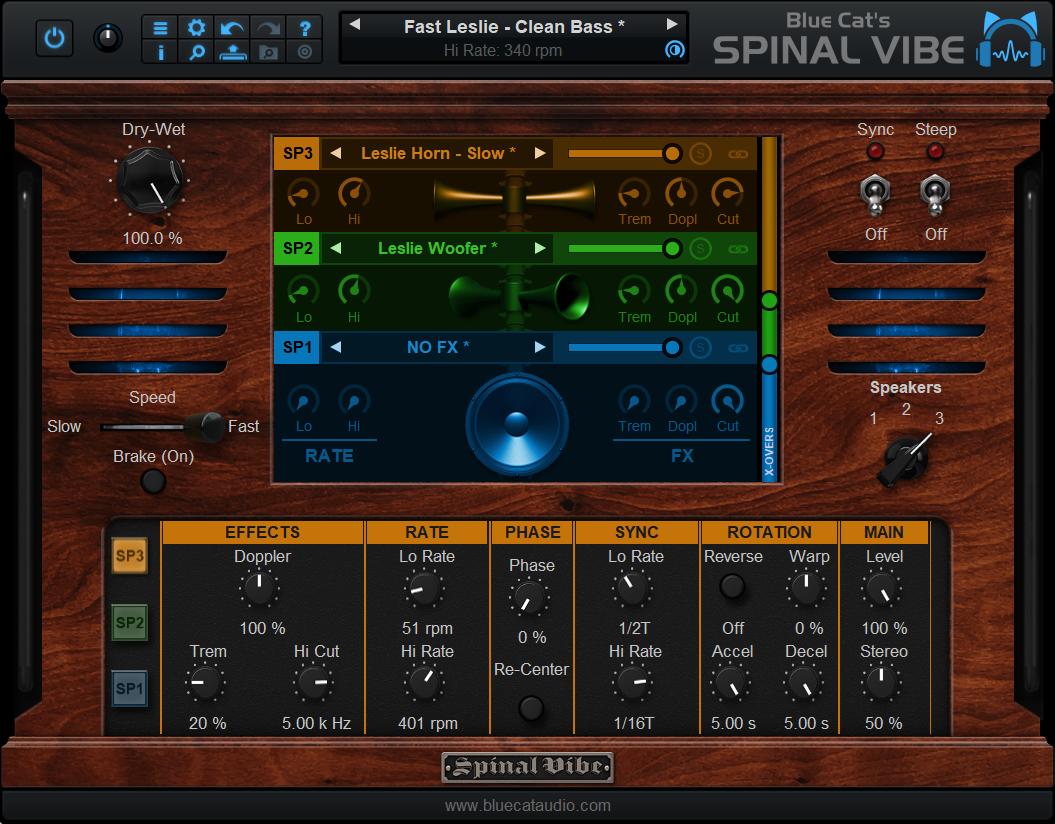Table Of Content
Introduction
Blue Cat's Spinal Vibe is a rotary (multi-)speaker emulator that goes way beyond the scope of traditional simulations, thanks to a couple of twists.
Spinal Vibe offers up to 3 rotative speakers, with full control over the rotational behavior of each speaker: you can not only select their rotation speed and curve, but also the amount of Doppler, amplitude modulation and dampening independently, as well as their acceleration and deceleration characteristics.
The plug-in provides a simple control to select either slow or fast speed and anything in between, together with a brake to stop the rotation instantly. The rotation can also be synced to the host tempo, and the phase of each rotating speaker can be adjusted too.
It is also possible to mix the dry signal with the rotated signal(s) together to create interesting phasing modulation effects thanks to phase cancellation.
More than a simple rotary speaker simulation, Spinal Vibe offers a wide range of modulation effects that can be produced by the rotation of several sound sources.
Note: the plug-in focuses on the effects produced by rotation, it does not include any distortion or specific speaker simulation. It can be combined with the Destructor plug-in for such purposes.
Typical applications: Rotating Speaker Simulation, Leslie Simulation, Tremolo, Chorus, Harmonic Tremolo, Modulation FX, Spatialization FX, Multiband Processing, Phasing.
System Requirements
MacOS
- An Intel or Apple Silicon processor.
- Mac OS 10.9 or newer.
- Any VST / Audio Unit / AAX compatible application (64-bit) .
Windows
- An SSE2-enabled processor (Pentium 4 or newer).
- Microsoft Windows Vista, Windows 7, 8, 10 or 11.
- Any VST / AAX compatible host software (32 or 64 bit).
For more information about supported platforms, see our Knowledge Base.
Demo Limitations:
- Limited number of instances of the plug-in per session.
- The plug-in is regularly bypassed for a few milliseconds.
Installation
The plug-ins versions cannot be run standalone: they require a host application (see the System Requirements chapter for more information). Depending on which host application you use, you might need to install the plug-ins in different locations.
Before installing one of the plug-in versions, you should close all your host applications.
Windows
Install
All versions of the plug-in provide an installation program. Follow the steps of the wizard to install the software on your machine. During the installation you will be asked where you want the software to be installed. For the VST version, you should install the plug-in inside the VST plug-ins folder used by your host application(s). The default path set in the installer should work for most applications, but you should check your host software documentation to know where it looks for VST plug-ins. For other plug-in types, you should just use the standard path.
Some applications will not automatically rescan the new plug-ins, so you might have to force a refresh of the plug-ins list.
Upgrade
When a new version of the software is released, just launch the new installer: it will update the current installation.
Uninstall
To uninstall the software, simply launch the "Uninstall" program that is available in the start menu or in the configuration panel. It will take care of removing all files from your computer.
Mac
Install
On Mac the plug-ins are available as drive images with an installer. After download, double click on the dmg file to open it. You can then double click on the installer (.pkg file) to install the package.
Note for Mac OS 10.15 Catalina or newer: you may have to right click on the installer and select "Open" instead of double clicking on the file to launch the installation if your computer is not connected to the Internet.
Upgrade
When a new version of the software is released, just launch the new installer: it will update the current installation.
Uninstall
To uninstall the software, simply remove the component(s) from their install location (move them to the trash):
- AAX plug-ins are installed in the /Library/Application Support/Avid/Audio/Plug-Ins/ folder
- Audio Units (AU) are installed in the /Library/Audio/Plug-Ins/Components/ folder
- RTAS Plug-ins are installed in the /Library/Application Support/Digidesign/Plug-Ins/ folder
- VST plug-ins are installed in the /Library/Audio/Plug-Ins/VST folder
- VST3 plug-ins are installed in the /Library/Audio/Plug-Ins/VST3 folder
If you want to completely remove all settings and configuration files, you can also remove these additional directories that may have been created on your computer:
- ~/Library/Preferences/Blue Cat Audio/[Plug-in name and TYPE], where TYPE is VST, AU, RTAS or AAX: global preferences.
- ~/Library/Preferences/Blue Cat Audio/[Plug-in name]: license information
- ~/Documents/Blue Cat Audio/[Plug-in name]: user data, such as presets, additional skins and user-created plug-in data.
Please be aware that these directories may contain user data that you have created. Remove these directories only if you do not want to reuse this data later.
First Launch
Blue Cat Audio plug-ins cannot be run standalone, they require a host application (see the System Requirements chapter for more information). Some host applications will require you to scan the plug-ins before they are available in the application.
If the plug-in is not available in the application, please check that it has been installed in the appropriate directory (with no host application running), and that the host application has scanned it.
Using Blue Cat's Spinal Vibe
Introduction
About Rotary Speakers
Rotary speakers have been used in music for a long time, on all sorts of instruments (organs, guitars...), and even vocals. One of the most famous incarnation is the Leslie speakers, composed of a boomer and a tweeter with different rotation speeds for different parts of the spectrum.
While Spinal Vibe can emulate the rotational effects of such a device, it can do much more, by offering full control over the behavior of each rotating speaker and the crossover filters that separate the signal between speakers.
Basic Rotary Effects

When a speaker rotates, it typically produces three types of effects:
- Amplitude Modulation: this is the most obvious. When the speaker is in front of you, the sound is louder than when it is turned to the opposite direction.
- Doppler Effect: When the speaker is moving toward the listener (or microphone) or in the opposite direction, the apparent speed of the sound source is different. This creates a change of pitch of the sound coming from the speaker, exactly like when an ambulance passes by.
- Dampening (Hi-cut filtering): when a rotating speaker is in a room, when facing the wall in the opposite direction of the listener, what can be heard is the reflection of the tone on the walls, combined with the sound produced by the rear of the speaker. This is usually equivalent to a low-pass (= hi-cut) filter, letting only the lower frequencies go thru.
To give you full control over the tone, Spinal Vibes lets you setup these three effects independently for all speakers. What truly makes the magic of a rotary speaker is the way these effects are combined together with appropriate phase and timing. The plug-in manages this for you.
Stereo
When recording a rotary speaker, it is possible to place two microphones in front of the device to get a stereo sound, and produce interesting spatialization effects. Spinal Vibe offers a "Stereo" parameter for each speaker. It is the equivalent of adjusting the angle between the microphones to control the "stereoness" of the rotation effect.
Spectrum Splitting: Crossovers
When using multiple speakers, each of them will be responsible for reproducing a specific part of the spectrum. Just like in the real world, this is done here with crossover filters:
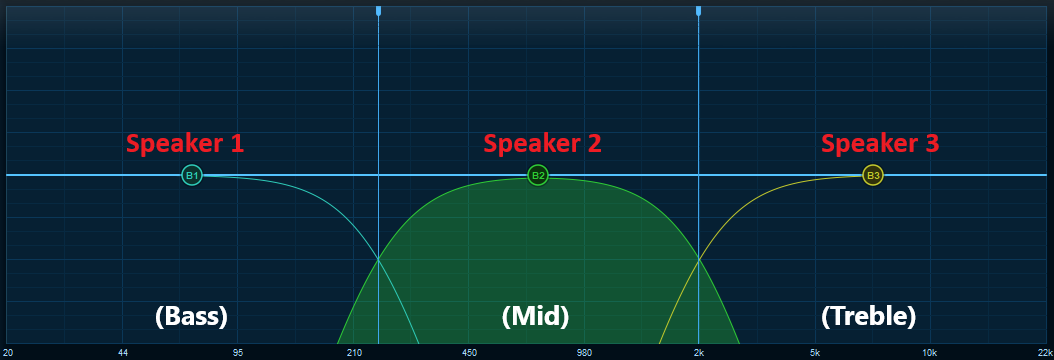
Spinal Vibe lets you choose between regular (12 dB/Oct) and steep (24 dB/Oct) crossovers to manage the separation between bands, and the crossover points (frequencies) can be adjusted.
When using one speaker, there is no crossover in action. With 2 speakers, only one crossover is necessary, while with 3 speakers, you get 2 crossovers.
Classic Tones And Beyond
Thanks to all these controls, the plug-in can be easily used to produce classic rotary speakers tones, as you can hear with the factory presets. You can also explore new tones quickly without digging into the details of each simulation by selecting factory subpresets for each speaker.
But with all these extra controls, the plug-in opens up a whole world of tonal possibilities. While keeping the basic character of rotating speakers, it is possible to go a lot further and create a wide array of modulation effects that would defy the physics of a rotating speaker. It's up to you to explore these capabilities and be creative with your tone.
Fortunately, Spinal Vibe provides some extra tools to make the exploration easier!
Tone Maps
Despite all these additional features, Spinal Vibe lets you find the right tone easily and explore its tonal capabilities without having to learn the influence of every single knob. Open the tone maps and explore new areas to find the right spot that works for you:
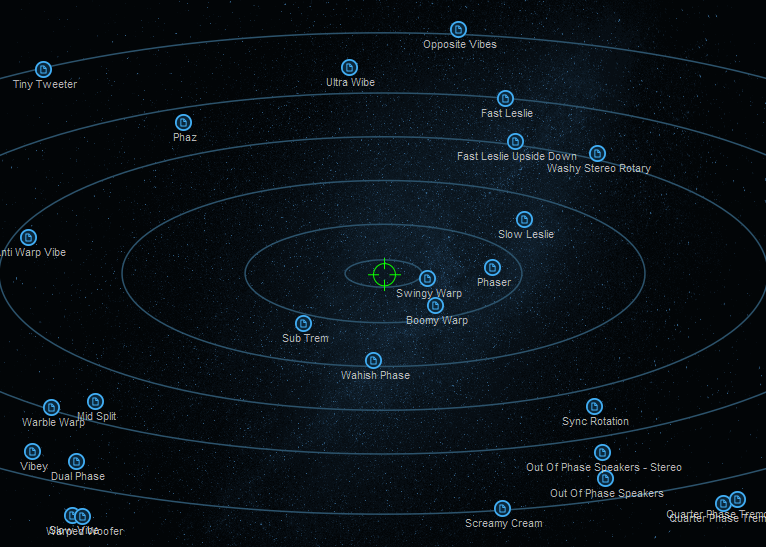
It is a very useful tool to navigate thru presets (tones that are similar will be close to each other) or to create brand new tones out of existing presets: place the cursor in the middle of several presets, and the plug-in will create a new tone based on the chosen location.
More...
And of course, as opposed to traditional rotary speakers, the plug-in can be synced with the host application for tempo & timeline-controlled modulation.
The User Interface
Note: The main toolbar, menus and basic features available with all our plug-ins are detailed in the Blue Cat Audio Plug-ins Basics section.
Overview
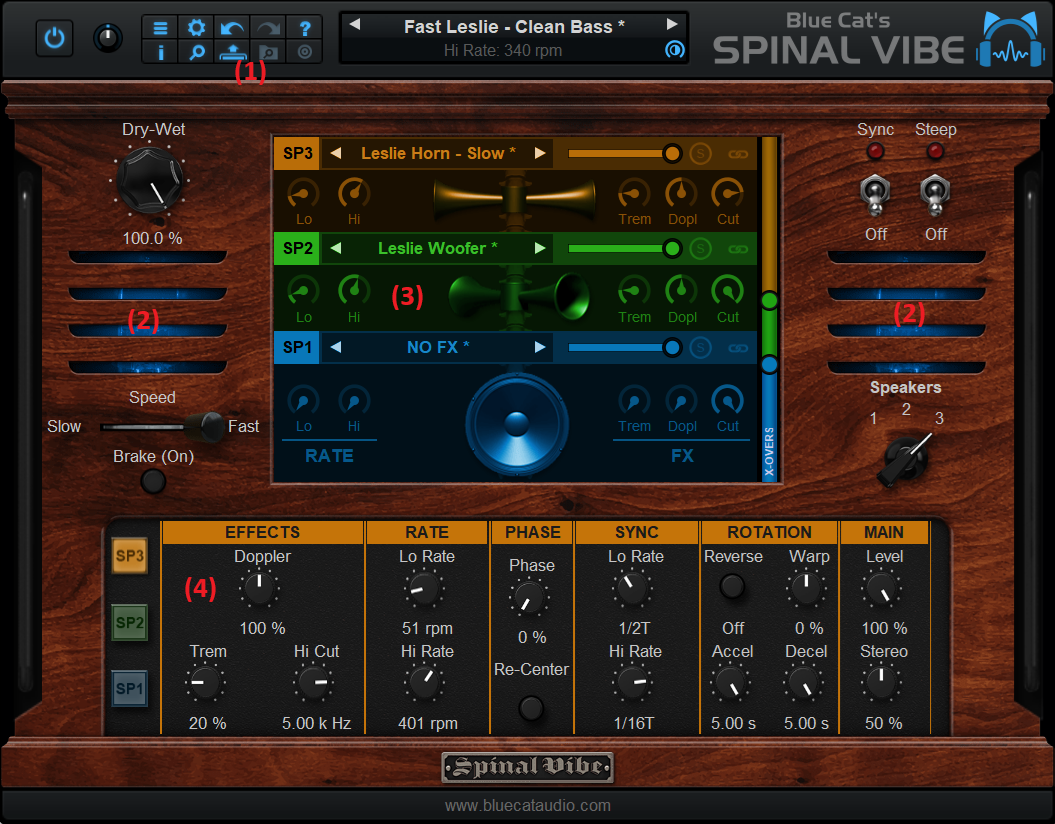
- Main toolbar.
- Global controls.
- Main Speakers configuration.
- Detailed speakers controls.
The Toolbar
In addition to the usual icons found in all our plug-ins, Spinal Vibes offers the following commands:

- Show/hide advanced speaker controls.
- Open the presets browser.
- Open the tone maps window.
Global Controls
From left to right, top to bottom:
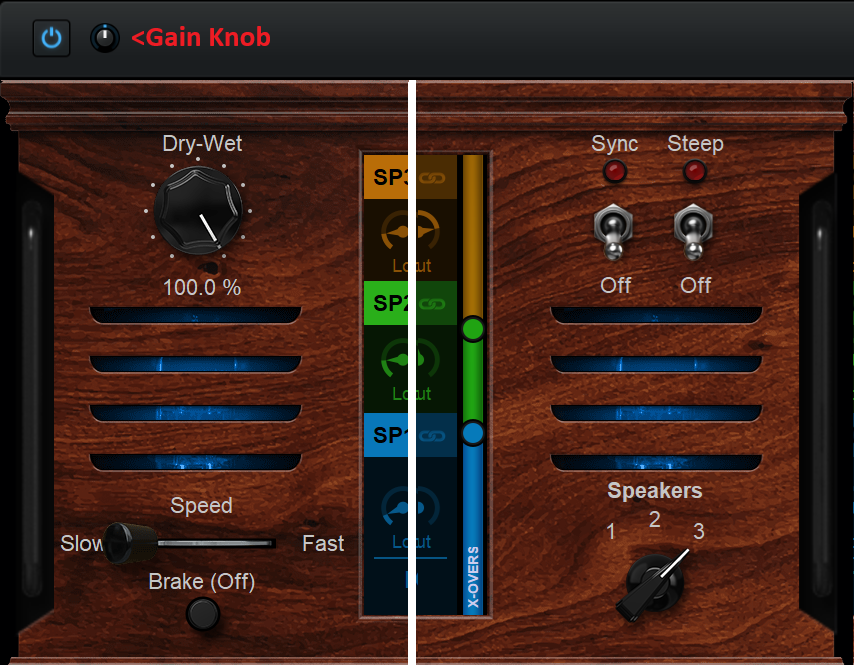
- Gain: adjust the gain at the input of the plug-in to adjust the volume (the perceived level may be affected by the rotating effect).
- Dry-Wet: amount of wet rotated signal vs dry input signal.
- Speed: select the global speed of the effect. Click on "slow" and "fast" to quickly switch between both rotation speeds, or move the slider to get anything in between.
- Brake: stops instantly the rotation when active, restarts it (with acceleration) when unchecked.
- Sync: synchronize the effect with the host, using the sync rates instead of rpms.
- Steep: select between smooth or steep curve for crossovers.
- Speakers: select the number of rotating speakers (up to 3).
Main Speakers Controls
You will find the main controls for the speakers as well as the crossover frequencies in the middle of the user interface:
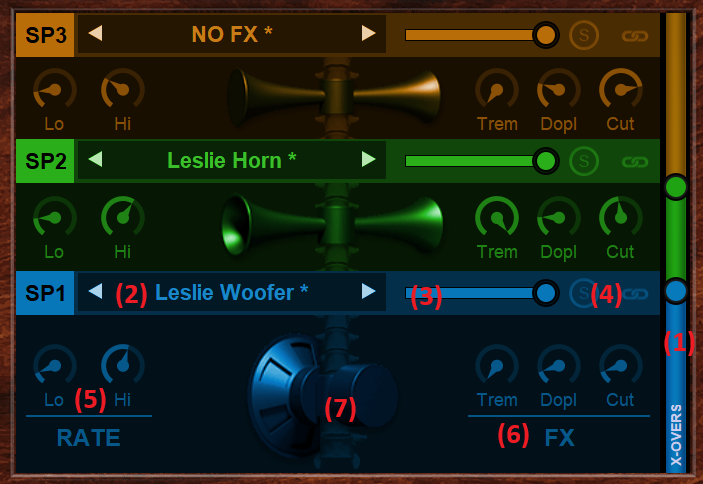
- Crossover frequencies: adjust the frequencies of the crossover filters that split the signal into multiple bands (one for each speaker). From bass (bottom) to treble (top).
- Speaker Preset: you can select a preset for each speaker, as well as save your own presets to recall your favorite settings quickly.
- Speaker Level: manage the output level (volume) of each speaker.
- Solo / Link: solo each speaker to hear only the output of this speaker. Use the link icon to link speaker controls together, to make changes to multiple speakers by moving a single control.
- Rates: adjust the low (slow speed) and hi (fast speed) rates for each speaker. In "sync", mode, these knobs adjust the sync rates of each speaker, or the RPM rates otherwise (more details below).
- FX: adjust the amount of amplitude modulation (trem), Doppler and dampening (Cut) effects for each speaker. Note that the Hi Cut knob is reversed compared to the other two as it controls the hi cut frequency (the lower, the more dampening).
- Speaker Display: each speaker is displayed on the screen according to its current rotating position. This visual feedback is very useful to monitor what is exactly going on under the hood.
Advanced Speaker Controls
It is possible to go deeper into the configuration of each speaker independently with the advanced speaker controls:

You can click on the SP1 to SP3 buttons to select a speaker. The speaker can also be selected if you click on its name in the main speaker view.
From left to right:
- Effects: these are the same controls as in the main view, to adjust the amount of each effect produced by the rotation of the speaker.
- Rate: slow and fast speeds of rotation of the speaker in rpms (revolutions per minute). These are used when host sync is off.
- Phase: shift the phase of the speaker compared to others (0% - no shift / 100% - full period). This can be used to generate special effects with specific phase shift between the speakers. In order to synchronize them (if you have been changing various settings such as the rotation speed), click on "center" to re-center all speakers according to their phase.
- Sync Rate: low and fast speeds of rotation of the speaker when host sync is on, expressed as musical durations.
- Rotation: adjust the behavior of the rotation. Rotation can be reversed (most interesting in a stereo context, but not only), and the acceleration and deceleration of the speaker can be configured. Warp simulates a speaker that does not rotate continuously. This allows you to add some "swing" to the rotation effect.
- Main: adjust the relative level of the speaker and the "stereoness" of the effect. The effect will sound natural up to 50% and creates extreme stereo variations above.
Browsing Presets
In order to browse both factory and user presets, you can either use the simple presets menu or open the full featured presets browser from the toolbar that remains visible until you close it:
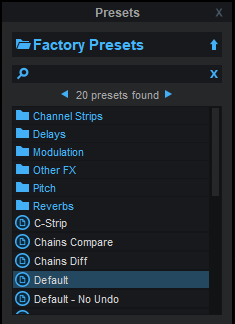
Click on preset files and folders to open them, or use the arrows to navigate between displayed presets. You can navigate upward in the folders tree by clicking on the current folder at the top. Type in the search box to find presets by name (it also searches in folder names). The search is performed recursively in the currently selected folder (displayed at the top).
Search Tips: you can search for multiple terms by separating them with commas. Wildcards are also supported (with * and ? characters), but they are applied to the full path of the preset. For example, to search for all presets containing the word "phase", type *phase* in the search box. To look for these presets only in the factory presets, you can type Factory Presets/*phase*.
Tone Maps
Another way to browse presets (and create new tones) is to use tone maps. Click on the tone map icon in the main toolbar to open the tones explorer window. It shows a presets browser on the left to look for presets (and load them), and a tone map on the right, which can be used to navigate presets and morph between them:
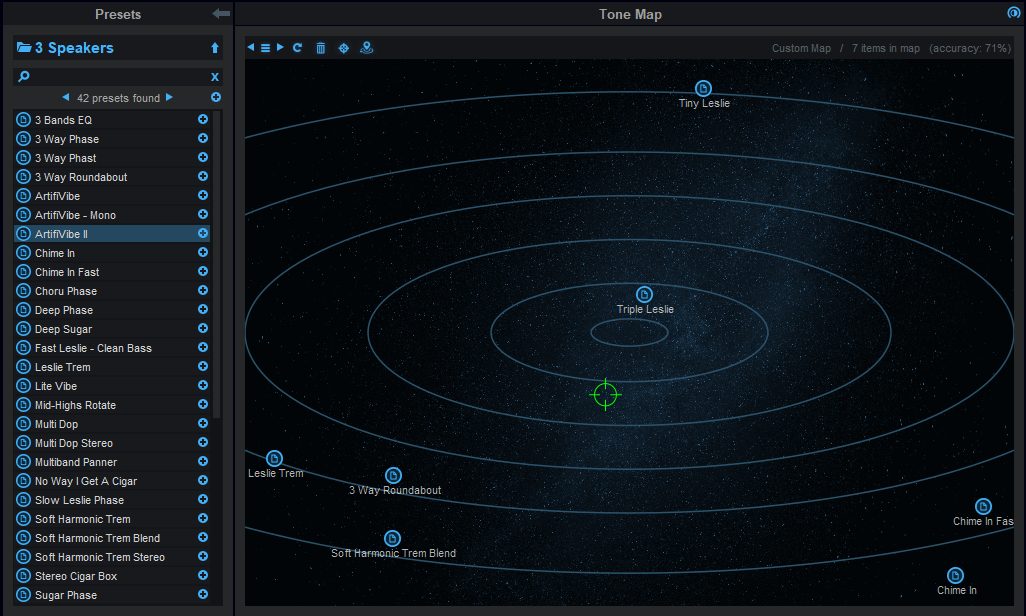
The preset browser pane shown here is the same as the main presets browser described earlier, with an additional "+" button that can be used to add presets to the current map.
The tone explorer window can be resized: move the mouse to the border of the window until an arrow appears, then click and drag to resize accordingly.
Tone Map Features
The main feature of the tone map area is to browse presets on a 2D map. You can click on the presets icons that appear on the map to load the presets, or move around the green cursor to explore other areas and morph between presets in two dimensions.
Located at the top of the tone map panel, the toolbar provides additional commands, from left to right:
- Save your maps and reload them later using the menu icon. Use the left and right arrows to go thru existing maps.
- If you modify the presets that compose a map, you can recompute the map using the refresh icon (presets that cannot be found anymore will also disappear from the map).
- Use the trash icon to reset and start with an empty map.
- Use the target icon to reveal the mouse cursor in the map (that may have disappeared once zoomed).
- The last icon lets you find the closest location on the map that fits the current settings. If the current settings have been loaded from a preset that is on the map, it will find this preset. An approximate location is computed otherwise (and will affect the current tone).
Once the map and its (green) cursor have focus, you can zoom the map using the mouse wheel. Once it has been zoomed, drag the map with the mouse to move it (or use the find cursor command to locate the cursor).
Tip: you can hide the tone map panel (using the arrow at the top of the window) if you want to use this window as a floating presets browser.
Getting Started With Tone Maps
The easiest way to get started with tone maps is to load factory preset maps that are included with the plug-in:
- Click on the menu icon and choose a map from the list.
- Start browsing!
Creating Your Own Maps
Factory maps are nice, but you will probably want to create your own and navigate your own tonal space with your favorite presets:
- Start with an empty map (click on the trash icon), or with an existing map that you like.
- Find presets with the browser, and add them to the map with the "+" icon (the "+" icon at the top of the results list add all of them).
- The map is computed on the fly and shows presets that sound similar at the same location. Adding new presets to an existing map may completely change its layout - it is the same as looking at an object from a completely different angle.
Have fun!
More
The various elements of the user interface (knobs, sliders, buttons...) are simple and intuitive to operate, but more information about how to interact with them is available in the "Plug-ins Basics" chapter of this manual.
Operation
Getting Started
Explore the Presets
The best way to get started is to go thru factory presets and select your favorites as a starting point to create your own. As you will see there are plenty of presets with different tones and settings, which should help you get started quickly.
Using Tone Maps
As explained earlier, tone maps are a great tool to explore the existing presets and create your own tone without dealing with the details of all the parameters:
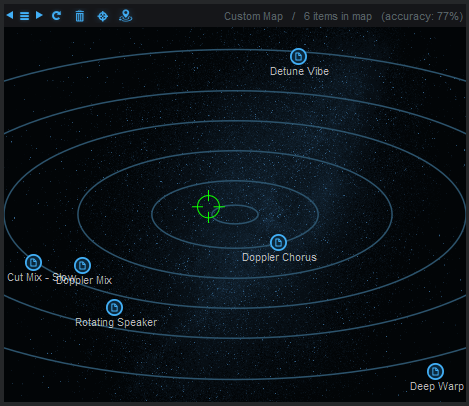
You can start with factory tone maps available from the menu, then create your own with your favorite presets, and find new tones by simply navigating between them.
Tip: since there is no possible state between 1 and 2 speakers, or 2 and 3 speakers, creating tone maps with presets using different numbers of speakers is not very useful.
Position In the Signal Chain
As many modulation effects, the plug-in may produce very different effects depending on where it is located in the signal chain, and with which other effects it is combined.
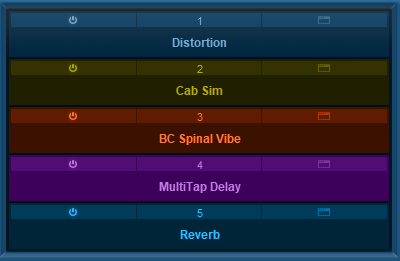
Rotary Speakers
If you are looking at simulating a "real "rotating speaker, the most classic way is to place the plug-in at the end of the chain, after distortions or amp simulations, but before delays and reverbs.
Whatever instrument you are using, you can combine Spinal Vibe with an amp and cabinet simulation such as Destructor right before, to reproduce most classic rotary speaker effects from the "real world".
Guitar Effects
Spinal Vibe is a great plug-in for guitars too. Many modulation effects will work fine before or after the amp simulation and distortion pedals but will produce very different tones, so you may want to experiment with various positions for each preset.
Creative Delays And Reverbs
It can be very interesting to place Spinal Vibe after delays and reverbs. While it will not simulate real rotating speakers cabinets, it will completely alter the delay and reverb tails, adding filtering or stereo placement to these otherwise pretty static tones. Try it out!
Experiment With Speed
The rotation effects produced by the plug-in are quite sensitive to the rotation speed. With a single preset, experiment various speeds as you may end up with many different types of tones.

Synchronized Rotation
When working on highly rhythmic parts or with tempo-synced effects, use Spinal's Vibe built-in synchronization feature to have the rotation synchronized with the song tempo and beats.

In this case, adjusting the phase will let you decide when each speaker gets in the front or back in relationship with the song grid.
Note: when switching to sync mode or changing the synchronized rotation speed, it may take a couple of turns to get the rotation fully synchronized with the beats.
Automate Parameters
All plug-in parameters can be automated in your DAW, and some of them are particularly interesting to experiment with. It's up to you to be creative and get dynamic effects with the plug-in. Here are a few examples to get you started:
- Crossover frequencies, for time-varying filtering.
- Global or individual speaker rotation speed.
- Speaker warp parameter: creates an acceleration or deceleration effect with actually changing the rotation speed.
- Reverse: for stereo speakers, reverse the rotation regularly on a track for interesting spatial effects.
That's just a few ideas to get you started. As you will notice, Spinal Vibe offers much more than rotary speaker emulation and experimentation is welcome!
Blue Cat Audio Plug-Ins Basics
This chapter describes the basic features that are common to all our plug-ins. If you are already familiar with our products, you can skip this part.
User Interface Basics
About Skins
Like all Blue Cat Audio plug-ins, Blue Cat's Spinal Vibe uses a skinnable user interface. It means that the appearance and behavior of the user interface can be entirely customized.
Especially with third party skins, the experience may be quite different from the one offered by the default skins that we provide. However, our plug-ins and our skinning engine have several standard features that will be available whatever your favorite skin.
More information about custom skins can be found in the skins section.
The Main Toolbar
In most skins, an optional toolbar at the top of the user interface gives you access to the main options and settings of the plug-in:

Smooth Bypass
On the left, the power button can be used to smoothly bypass the plug-in.
Presets Area
At the center of the toolbar, you can see the current preset area (the "Default Settings" box). It displays the name of the current preset, with a "*" at the end if it has been modified since loaded.
The arrows on the left and right let you navigate thru the (factory and user) presets available for the plug-in.
Clicking on the preset name opens the presets menu which lets you manage the presets of the plug-in.
Using the knob on the bottom right of this area, you can reduce the opacity of the window, and make it transparent (the actual result may depend on the host application). Additional messages may appear in the area next to this knob, depending on the plug-in.
Some plug-ins may also propose you to manually select the audio I/O inside the plug-in (bottom left of the presets area), regardless of the host configuration. It can be useful for example to save CPU by selecting mono to stereo configurations (instead of full stereo sometimes chosen by default by the host), or add extra channels to manage side chain internally, when the host does not provides any side chain input. Please note that this does not change the number of I/O seen by the host application.
Commands
The icons in the toolbar give you access the to the following commands that are detailed in the next paragraph:
| Icon | Name | Function |
|---|---|---|
|
|
Menu | Open the main menu |
|
|
Control Settings | Display the controls settings menu (to manage automation and MIDI control, as described here). |
|
|
Undo | Undo |
|
|
Redo | Redo |
|
|
Manual | User Manual |
|
|
About | About |
|
|
Zoom | Scale the user interface (from 70% to 200%). |
The Main Menu
The main menu is available from the main toolbar, or if you right click anywhere on the background of the plug-in:
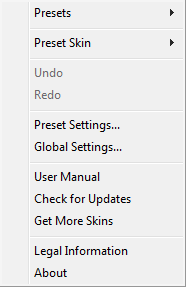
- Presets: opens the presets menu to manage presets.
- Preset Skin: opens the skins menu to choose the skin for the current preset and manage alternative skins for the software.
- Undo/Redo: undo or redo the latest modifications. This includes all changes made to the current preset settings such as MIDI or automation preferences.
- Presets Settings: open the presets settings window. It lets you change the skin, MIDI and automation settings for the current preset.
- Global Settings: open the global settings window. It lets you change the skin, MIDI and automation settings that are used by default in all instances of the plug-in (if not overridden by the current preset).
- User Manual: open this user manual.
- Check for Updates: opens up our website to let you check if any update for this software is available.
- Get More Skins: get more skins for this software.
- Legal Information: browse licensing and misc legal documents.
- About: displays the “about” dialog box.
Controls
Examples
Here are a few examples of typical controls you will encounter in the user interface of our plug-ins:
| slider | slider | knob | button | Text control |
|
|
 |
 |
|
|
Interacting with Controls
You can interact with the controls of the plug-in interface either with the mouse or the keyboard.
Setting the keyboard focus on a control (so that it responds to key strokes) may be automatic (when you pass the mouse over it it gets focus) or manual (you have to click on the control to set the focus on it). Note that all host applications behave differently regarding keyboard handling. In some applications you may not be able to use all keys described later in this manual to interact with our plug-ins. It is usually made obvious to you to know the active surfaces of the skin (the places where you can click with the mouse): the mouse cursor usually changes when you can do something on a control. In the default skins delivered with the plug-in, the cursor changes to a small hand or an arrow to tell you when your mouse is over an active control.
Mouse
Various mouse movements will let you interact with the controls:
| Mouse Interaction | Action |
|---|---|
| Left Click | Acquire focus and start dragging or push (button) |
| Left Click + Alt Key | Set the value to default |
| Left Double Click |
Acquire focus and launch the “fine
tuning” edit box (except button):
 |
| Right Click | Set the value to default |
| Mouse Wheel | Increment or decrement the position (focus required) |
| Mouse Drag | Change the control position depending on mouse movement (except button) |
Keyboard
All control widgets support the following keys (note that some of them are caught by the host and thus never forwarded to the control. For example in Steinberg Cubase SX you cannot use the arrow keys to control the plug-in):
Keys Common to All Controls
| Key | Action |
|---|---|
| Up Arrow | Small increment of the position (up or right) |
| Down Arrow | Small increment of the position (down or left) |
| Left Arrow | Same as Down Arrow |
| Right Arrow | Same as Up Arrow |
| Page Up | Large increment of the position (up or right) |
| Page Down | Large decrement of the position (down or left) |
| + | Small increment of the value of the control |
| - | Small decrement of the value of the control |
| d | Set to default value (same as mouse right click) |
| e |
Opens the 'fine tuning' window to precisely
set the parameter:
 |
| SHIFT | When the key is down, the fine tuning mode is on, and you can modify the value with better precision when moving the mouse, the mouse wheel or using the keyboard. Just release the key to get back to the normal mode. |
Keys Specific to Buttons
| Key | Action |
|---|---|
| Enter | Pushes the button |
Presets
To get started with the plug-in and discover its capabilities, a couple of factory presets are provided. You can also save your own presets and recall them later for other projects. Our plug-ins propose a full-featured preset manager to let you save, browse, organize and recall its presets.
The Presets Menu
The presets menu can be opened from the main menu or the main toolbar. It displays the list of presets available for the plug-in as well as commands to load, save or organize presets:
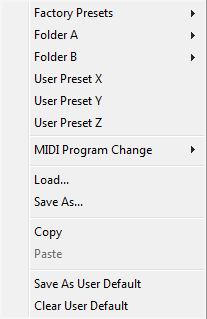
- Factory Presets: shows the list of factory presets delivered with the plug-in.
- "Folder A" to "User Preset Z": user presets and categories.
- MIDI Program Change: activate MIDI Program Change support (see below).
- Load: load preset from file.
- Save: save current state to last loaded user preset.
- Save As: save current preset to a file.
- Copy copy preset to the system clipboard.
- Paste paste preset from the system clipboard, if available.
- Save As User Default: save the current state as the default preset. This preset is used every time a new instance of the plug-in is created.
- Clear User Default: reset the default preset to its factory state: this makes the plug-in forgets the custom settings you might have saved as a default preset.
More about Presets
There are two types of presets: factory presets (read only) that are provided with the plug-in, and user presets that can be created and stored by the user.
The user presets are stored in a subdirectory of the documents folders of your profile ("Documents" on Mac, and "My Documents" on Windows): Blue Cat Audio/[Plug-in Name]/Presets. Each preset is stored as an individual file. You can create folders and subfolders in the Presets directory to classify your presets, as shown in the example below:

If you save a preset named "Default" in the root Presets directory, it will override the factory default preset (that's what "Save As Default" does). To restore the factory default preset, you can just remove this file or use the "Reset Default" command.
MIDI Program Change
It is possible to load presets remotely using MIDI "Bank Select" and "Program Change" messages. To enable this feature, select a MIDI channel to receive the events from in the MIDI Program Change menu item from the presets menu:
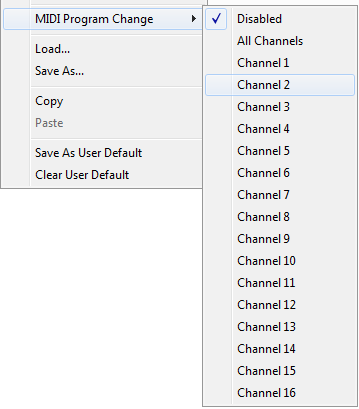
This setting is saved for each plug-in istance with your session but not in presets (except for the default preset, using the "Save as User Default command"). Once activated, the plug-in menu will display the bank number followed by the preset number for each preset:
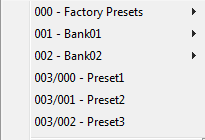
Every root folder is considered as a new bank, starting with the factory presets (bank 0). Program and bank numbers may change while you add folders and presets, so you should be careful when naming them if bank and program numbers matter to you. It is recommended to use folders to make this task simpler. As a side note, sub folders do not define additional banks (all presets contained in sub folders are associated with the current bank.
As specified by MIDI, bank select messages are not used until a program is actually selected.
MIDI Implementation note: the software supports all types of Bank Select methods. You can use either MIDI CC 0 or MIDI CC 32 to select banks. If both are used simultaneously, they are combined together so that you can use more banks (in this case CC0 is LSB and CC32 is MSB, and actual bank number is 128*CC0+CC32).
MIDI and Automation Control
Blue Cat's Spinal Vibe can also be remotely controlled via MIDI using MIDI CC ("Control Change") messages or automation curves, if your host application supports it. It is possible to customize the channel, control numbers, range and response curve used for each parameter in the settings panel available from the main menu (see the Plug-in Settings chapter for more details).
MIDI and Automation Settings Menu
The main menu
Most skins also provide the ability to change MIDI and automation settings directly in the main user interface. Clicking on the control settings icon in the main toolbar opens the following menu:
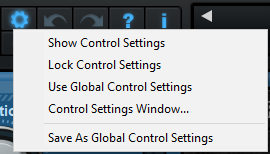
- Show Control Settings: show direct access to individual control settings for each parameter in the user interface (see next paragraph).
- Lock Control Settings: lock the current controls settings for MIDI and automation so that they remain unchanged when loading presets.
- Use Global Control Settings: ignore the current MIDI/automation settings and use the global settings instead.
- Control Settings Window: display the control settings window, to change control settings for all parameters.
- Save As Global Control Settings: save the current settings as global settings (used by default, when no specific MIDI/Automation setting has been set for the cuirrent preset).
Individual Control Settings
When this feature is activated using the "Show Control Settings" item in the MIDI and Automation Settings menu, dropdown menu buttons appears next to the main controls displayed by the plug-in:
Clicking on this button shows the MIDI/Automation settings menu:
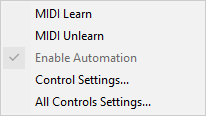
- MIDI Learn: launches MIDI learn mode for the control: touch your MIDI controller and the control will learn from it the MIDI channel and CControl Number. To end the learn mode, reopen this menu and deselect the option.
- MIDI Unlearn: deactivates MIDI control for this parameter.
- Control Settings: launches the advanced settings panel described below. This controls the settings for the current preset.
- All Control Settings: display the control settings window, with access to all parameters.
Advanced MIDI and Automation Settings
You can completely customize the way the plug-in is controlled by automation and MIDI. For a global view of all parameters at a time, you can use the Plug-in Settings window for the current preset which is available from the main menu.

MIDI Settings:
- Enable MIDI: enable/disable the MIDI control of the parameter.
- Channel: MIDI Channel for the parameter control. If set to 0, the plug-ins will accept Control Change Messages from all MIDI Channels (MIDI Omni mode).
- CC: Control Change Number.
- Learn: click on this button to activate the MIDI learn functionality. When it is activated, you can move your MIDI controller, and the plug-in will automatically detect the control settings .
MIDI and automation settings:
- Response: response curve of the MIDI or automation control: from very fast to slow control.
- Min: minimal value of the parameter when MIDI controlled or automated.
- Max: Maximum value of the parameter when MIDI controlled or automated.
Note: if the Min value is higher than the Max value, the response curve will be reversed: increasing the control value will decrease the parameter value.
Note: if you double click on the parameter text control boxes for the max and min values, a “fine tuning” edit box will appear and let you change the min and max values with more precision:

More
Check our online tutorial for more screenshots and more examples of our plug-ins user interfaces.
Plug-in Settings
In addition to the controls offered in the main user interface, Blue Cat's Spinal Vibe has various settings that let you fine tune the behavior of the plug-in. You can choose to change these settings either for the current preset or globally for all instances of the plug-in.
The Global Settings Window
The settings available in this window apply to all instances of the plug-in, for all presets, if not overridden in the presets settings. Consider these settings as “default” settings.
General
You can change the default skin for all instances of the plug-in: write the skin file path in the text edit box or click on the button to open a file chooser dialog. If you have several instances of the plug-in opened in your session, you will have to re-open the user interfaces of these plug-ins to see the skin change.
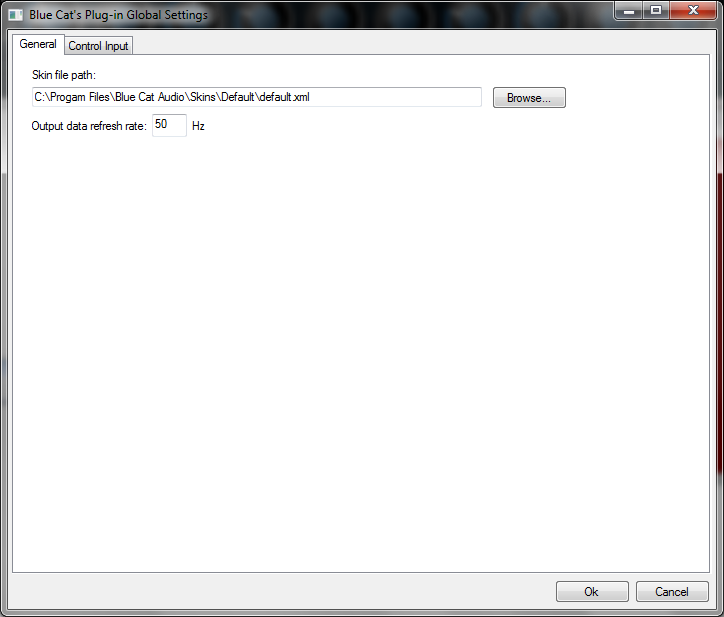
The output data refresh rate can also be customized for all instances of the plug-in. It controls the refresh rate of non-audio data produced by the plug-in (parameters, curves...). It also controls the refresh rate of output MIDI CC messages or output automation data. The higher the refresh rate, the better precision, but also the higher cpu usage (some host applications may also have trouble recording MIDI data at high refresh rates). The default value is 50 Hz.
Global Control Input Settings (MIDI and Automation)
The plug-in offers a couple of settings that affect the way it is controlled by MIDI messages or automation. While the first settings only apply to MIDI control, the "Control Response", "Min" and "Max" settings apply to both automation and MIDI control.
For each parameter you can define a default MIDI channel and CC number. You can then control the plug-in with an external MIDI controller or one of our plug-ins that generate MIDI messages.
The settings below are available for each plug-in parameter.
MIDI Settings:
- Enable MIDI: enable/disable the MIDI control of the parameter.
- Channel: MIDI Channel for the parameter control. If set to 0, the plug-ins will accept Control Change Messages from all MIDI Channels (MIDI Omni mode).
- CC: Control Change Number.
- Learn: click on this button to activate the MIDI learn functionality. When it is activated, you can move your MIDI controller, and the plug-in will automatically detect the control settings .
MIDI and automation settings:
- Response: response curve of the MIDI or automation control: from very fast to slow control.
- Min: minimal value of the parameter when MIDI controlled or automated.
- Max: Maximum value of the parameter when MIDI controlled or automated.
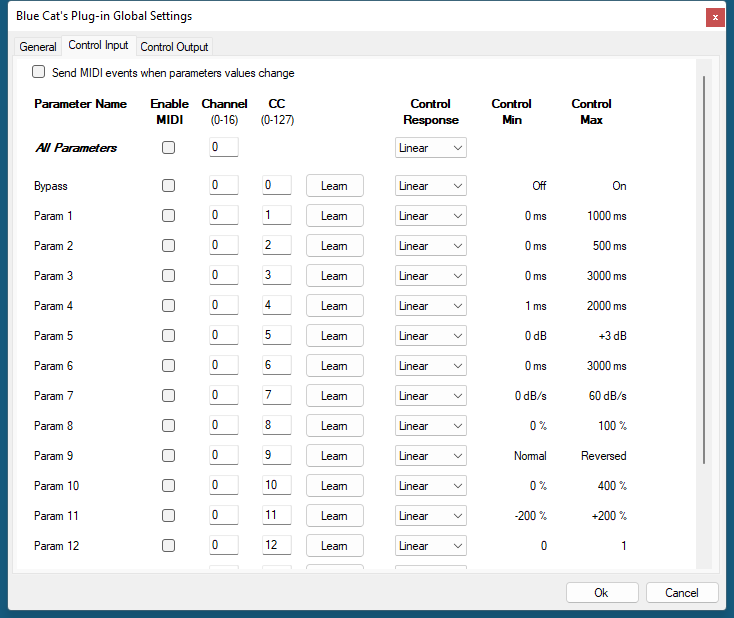
Note: if the Min value is higher than the Max value, the response curve will be reversed: increasing the control value will decrease the parameter value.
Note: if you double click on the parameter text control boxes for the max and min values, a “fine tuning” edit box will appear and let you change the min and max values with more precision:

"Send MIDI events when parameters values change": activate this option when using a control surface that accepts MIDI events as input. MIDI messages will be sent to the output of the plug-in when the user change the parameters values in the user interface, to keep the software and the controller in sync. MIDI is only sent for parameters that are activated for MIDI control.
The Current Preset Settings Window
In this window you can change the settings for the current preset of the current instance of the plug-in only.
Preset Skin
You can choose to use the global skin setting or to change the skin for the current preset. This way you can have different skins for different instances of the plug-in in the same session in order to differentiate them.
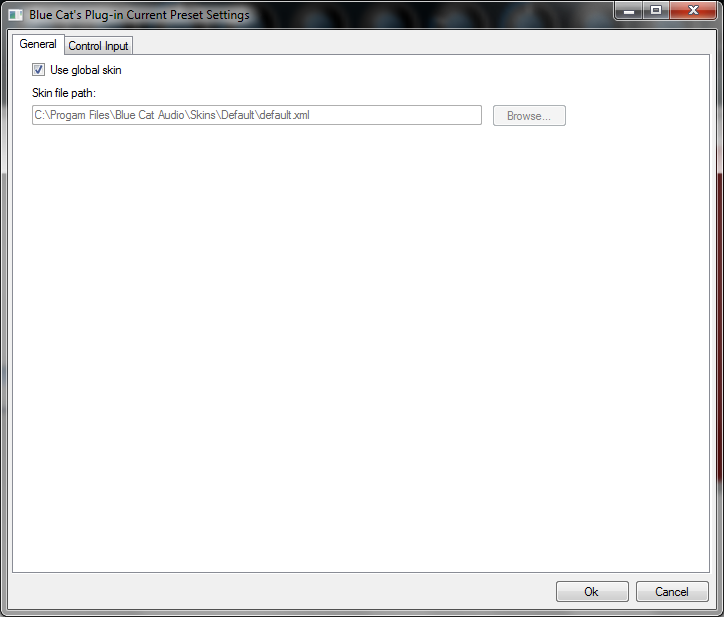
Preset Control Input Settings (MIDI and Automation)
Use the global settings or override them for the current preset. The parameters are the same as for the global input settings.
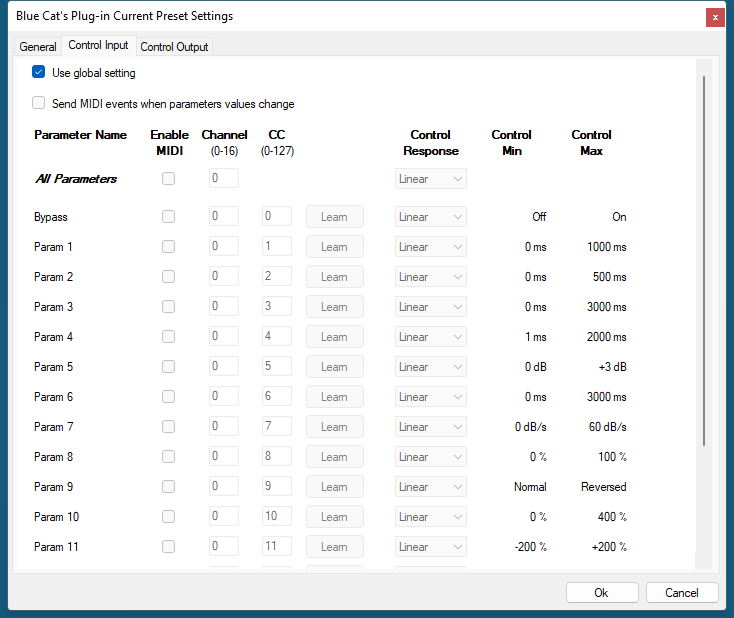
About Skins
Blue Cat's Spinal Vibe integrates Blue Cat's skinning engine that allows you to customize the user interface. You can download alternate skins for your plug-in at the following address:
If you don't find a skin that fits your need or if you want a custom one, you can choose to create your own skin.
Choosing the Skin
There are two ways to select the skin of your plug-in: you can change the default (or 'global') skin, or change the skin for the current preset only (either in the preset settings page or from the main menu). The global skin applies to all plug-in instances (choose this one if you want to use the skin used by default, regardless of the session or preset), whereas the current preset skin only applies to the current preset of the current plug-in instance (use this one if you want to change only the skin for the current session/preset).
Note: in some host applications, the plug-in window won't resize automatically when you choose a skin with a different size. In this case, just close the window and re-open it: it will be displayed with the right size.
The Skins Menu
The skins menu can be opened from the main menu. It displays the list of skins available for the plug-in as well as commands to manage the skin used by default when no preset skin has been selected:
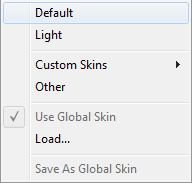
- First Section - Factory Skins: shows the list of factory skins delivered with the plug-in ("Default" and "Light" in this example).
- Second Section - User Skins: shows the list of user skins that have been installed in the Documents Skins folder for the plug-in (see below).
- Use Global Skin: use the global skin for the current preset/session (unloads any custom skin previously selected for the current preset).
- Load: opens a file browser dialog to manually select the skin from the file system.
- Save As Global Skin: use the current preset skin as the global skin (loaded by default if no preset skin has been defined).
Installing User Skins
To select user skins directly from the skins menu, install them in the "Skins" directory available in the plug-in's documents folder:
[Your Documents Folder]/Blue Cat Audio/[Plugin Name]/Skins/
The skin engine will scan this folder for new skins (xml files) and display them in the menu. The skin files should be in the root skins folder or in a subdirectory inside this folder: subdirectories are not scanned recursively.
Other Methods to Select Skins
You can also select the skins in the settings panels available from the main menu:
The global skin (used by default if no preset skin has been selected) can be changed in the global settings pane. The current preset skin can be changed in the preset settings page .
Create a Custom Skin
You can create custom skins for your plug-in in order to adapt it to your exact needs. You can change its look and feel and make it completely integrated in your virtual studio!
Just read the Blue Cat's Skinning Language manual and download the samples for the tutorial on http://www.bluecataudio.com/Skins. You can get ready to create your own skins in a few minutes. You can then share your skins on our website.
More...
This manual only covers the main aspects of Blue Cat's Spinal Vibe. Our website offers many additional resources for your Blue Cat's Spinal Vibe plug-in. It is constantly updated, so keep an eye on it!
Updates
As you can see in the history log below, we care about constantly updating our products in order to give you the latest technology available. Please visit our website often to check if Blue Cat's Spinal Vibe has been updated, or subscribe to our Newsletter to be informed of the latest news about our products.
Note: minor version updates are available from the same location as the original full version download (link received by email upon purchase). The demo version publicly available on our website will not let you register.
You can also follow us on twitter, facebook and instagram for almost real time updates notification, and subscribe to our YouTube channel to watch the latest videos about our software.
Versions History
Thanks again for choosing our software!

See you soon on www.bluecataudio.com!

